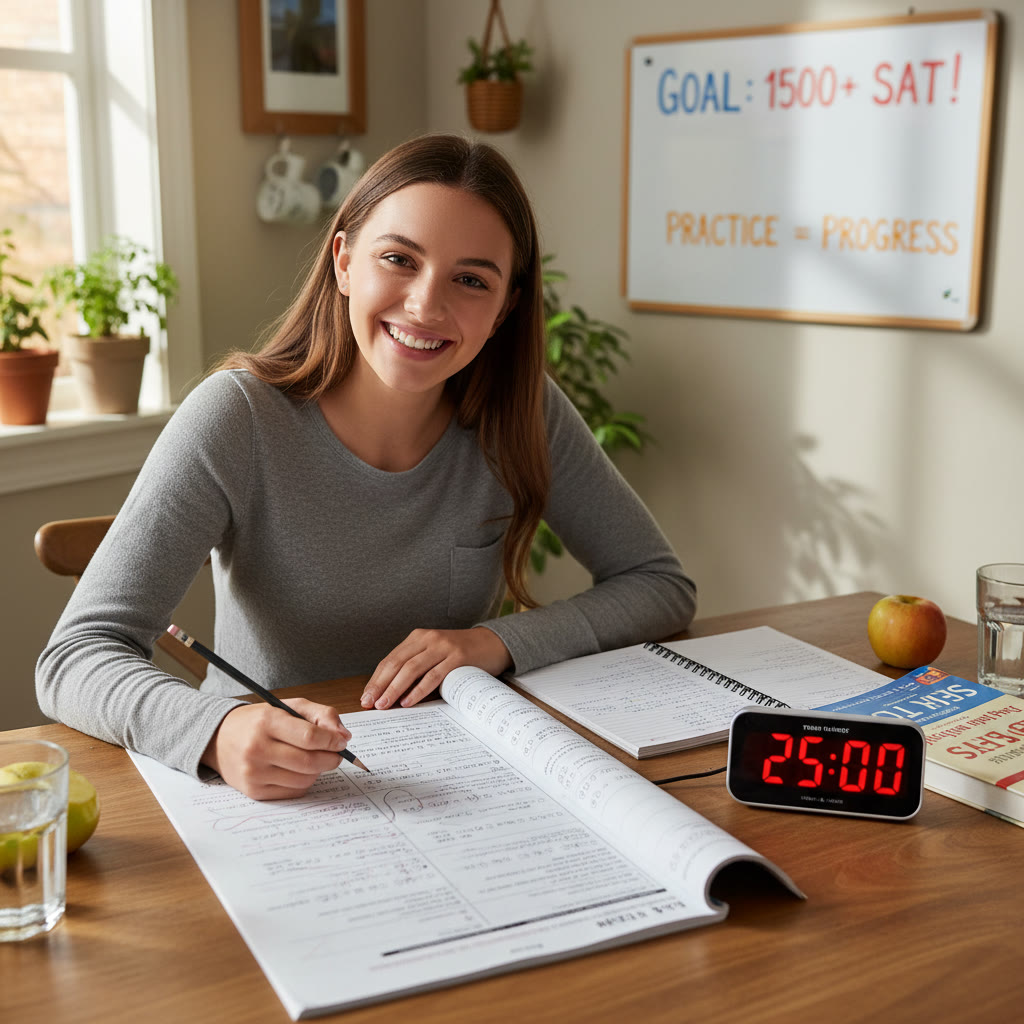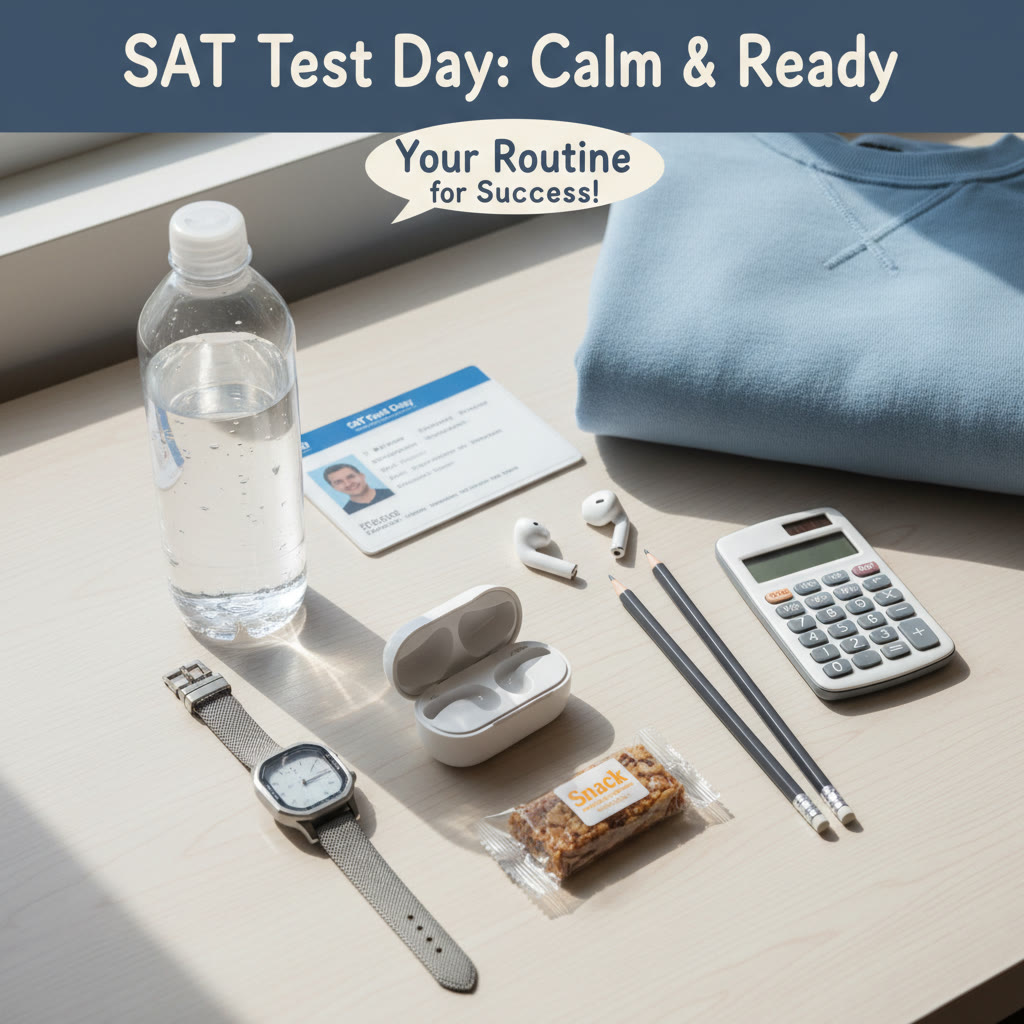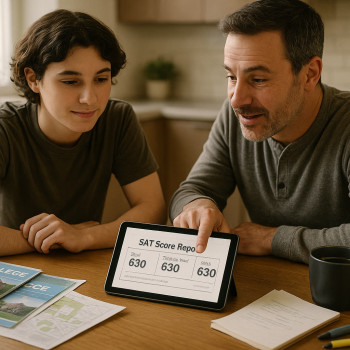Why your practice SAT score and your real SAT score can tell two different stories
It happens all the time: you take a practice SAT, feel confident, and celebrate a 1400. Then test day arrives and the score you open feels like a different language. Or maybe the opposite: your practice tests were middling, but you surprised yourself with a strong real score. Either way, those mismatches are frustrating and confusing. The truth is, practice scores are incredibly valuable — but they are not perfect predictors. They’re signals. Knowing why they differ from your real score is the first step to using them smarter.

Short answer: many small factors add up
Think of the SAT score as a final dish. Practice tests give you the ingredients and an early taste, but test day brings a different oven, a different chef, a different hunger level. Several small differences between practice conditions and test-day conditions can compound into a noticeably different result.
Key reasons practice and real scores diverge
- Test environment and timing: Were you interrupted? Did you take breaks that weren’t allowed? Practicing in a living room with a phone nearby is not the same as being at a testing center with a proctor and a strict clock.
- Effort and motivation: Practice tests sometimes feel less “real.” If you don’t replicate the stakes, you might not push through a hard section the same way.
- Test anxiety and arousal: Nerves on test day can slow reading, jumble thought processes, and make time feel shorter. Conversely, some students perform better under pressure.
- Differences in practice material: Not all practice tests are created equal. Official College Board practice tests are closest to the real test; third-party materials can vary in difficulty and style.
- Scoring nuances and rounding: The SAT uses scaled scores and equating to account for slight changes in test difficulty across administrations. That can shift a raw score a tiny bit.
- Test format changes: Taking paper vs. digital practice can change timing and comfort, especially after the recent shift toward digital testing in many regions.
- Fatigue and logistics: Poor sleep, travel to the test center, or a rushed morning can sap performance even if you were prepared.
How to interpret practice scores properly — a practical framework
Instead of treating a practice score as a prediction, think of it as diagnostic data. Ask three questions:
- What was the testing environment like?
- Which mistakes repeated the most?
- Were you simulating test day conditions?
If you answer honestly, the practice score becomes a tool for targeted improvement rather than an oracle. For example, a 20-point drop in the Math section might point to time-management issues; a steady pattern of careless mistakes suggests a need for focused accuracy drills, not more content review.
Example: two students, same practice score, different real outcomes
Maria and Jamal both scored 1250 on a practice test. Maria always takes her practice tests with snacks, breaks, and a Spotify playlist. Jamal simulates testing conditions: no phone, strict timing, no breaks. On test day, Maria scored 1180 — distracted and anxious — while Jamal scored 1280. The practice score told both of them what they could do with further study, but only Jamal’s method had simulated the test-day pressures that matter.
Concrete causes, with real-world fixes
Let’s break down common causes of score mismatch and what to do about each.
| Cause | How it affects score | Fix |
|---|---|---|
| Unrealistic practice conditions | Overestimates score; misses time pressure | Simulate test day: timed sections, no phones, identical breaks |
| Low test-day energy or anxiety | Underperforms vs practice | Practice breathing, do a dress rehearsal, get strategic sleep and nutrition |
| Poor material quality | Practice scores either too optimistic or too pessimistic | Use official College Board practice materials and mixed sources for variety |
| Timing and pacing mismatches | Sprint sections cause missed questions | Do timed drills, sacrificial practice of pacing strategies |
| Scoring quirks and equating | Small score jumps or falls despite similar raw performance | Track raw vs scaled scores and focus on accuracy improvements |
Mini case study: how pacing cost a student 50 points
Ken was a strong reader but slow. On practice tests he often finished Reading with 5–8 minutes left because he took longer on passages. On test day, pressure and fatigue slowed him a bit more; he ran out of time on a couple of questions and guessed on them, dropping his Reading score by 50 scaled points. After identifying the issue, Ken used targeted timed-passage drills and learned to flag and move on; his next official score rose accordingly.
How to make practice scores more predictive
If you want practice scores to be meaningful predictors — not just morale boosters or wake-up calls — adopt a mindset of faithful simulation and data-driven improvement.
Checklist to simulate test day
- Use official College Board practice tests when possible.
- Turn off phones and notifications.
- Strictly time each section; follow the same order and breaks as the real test.
- Practice with the same tools you’ll use on test day (paper or digital).
- Create a quiet, proctor-like environment: no music, no snacks during sections.
- Dress like test day — comfortable and ready for a long session.
- Do at least one full-length practice test as a dress rehearsal close to the real test date.
Drill smarter, not just harder
Many students believe the only way to improve is hours of full-length tests. Time is valuable; a smarter approach mixes full-length tests with focused practice:
- Targeted skill blocks: 30–45 minutes on algebra or sentence structure drills.
- Error logs: Keep a small notebook of every mistake and why it happened.
- Timed micro-practices: 10–15 minute drills to build speed on common problem types.
- Mindset and strategy sessions: practice calming techniques, timing strategies, and question triage.
Interpreting score jumps and drops
Small swings (+/- 20–40 points) are normal; big swings deserve investigation. Here’s an approach to read a practice-to-real gap:
- If you underperformed: look at sleep, nutrition, and anxiety. Then audit your pacing and content gaps.
- If you overperformed: check whether you were taking the practice test in an ideal setting and whether you used easier-than-official material.
- Track consistency: a student with scores clustered tightly around a number is more likely to see that range on test day than someone whose practice scores jump around.
Sample score comparison (realistic breakdown)
| Student | Practice (avg) | Real | Likely causes |
|---|---|---|---|
| Alice | 1320 (R 650 / M 670) | 1250 (R 600 / M 650) | Test anxiety, rushed Reading, and unusual wording on a long passage |
| Brandon | 1180 (R 580 / M 600) | 1210 (R 610 / M 600) | Better focus on test day, recovered from earlier fatigue |
| Camila | 1410 (R 700 / M 710) | 1380 (R 690 / M 690) | Minor time issues in Math; practice was slightly easier |
Psychology matters: mindset, rituals, and test-day routines
Scores aren’t just numbers — they reflect human states. Small psychological interventions can have outsized effects.
Rituals to stabilize performance
- Wake and eat the same breakfast you’d have on test day during dress-rehearsals.
- Practice a 2-minute breathing routine to calm nerves before each section.
- Use a consistent warm-up: a few quick mental math problems or a short reading passage to get “in the zone.”
- Rehearse logistics: know where your test center is, what you’ll bring, and when you’ll arrive.
These small rituals build familiarity and reduce decision fatigue on the big day. They won’t raise your score by 200 points overnight, but they can keep your practice-level performance steady under pressure.
When practice tests disagree with each other
It’s common to use multiple resources. Sometimes one practice test will be easier and another harder. Here’s how to balance them.
- Weight official College Board tests most heavily when predicting scaled scores.
- Use varied third-party tests for exposure to different question styles.
- Analyze item types, not just raw score: does one test have more tough algebra or denser reading passages? That’s useful to know.
How personalized tutoring closes the gap
General study plans help; targeted, personalized help accelerates progress. When practice scores vary widely from real scores, a trained tutor can identify the underlying causes faster than solo study. That’s where Sparkl’s personalized tutoring shines. Tutors provide 1-on-1 guidance, tailored study plans, and expert feedback that zero in on the exact skills — pacing, specific algebra topics, or reading strategies — that hold you back. Sparkl also uses AI-driven insights to track your error patterns, prioritize drills, and evolve the plan as you improve.
What a good tutoring program does differently
- Diagnoses the difference between careless errors and conceptual gaps.
- Builds a realistic test simulation schedule tailored to your calendar.
- Teaches test-day strategies: question triage, guessing approaches, and anxiety management.
- Uses data from multiple practice tests to set achievable score goals and milestones.
Realistic expectations: how much swing is normal?
Expect some variance. Smaller students often see +/- 20–40 points between practice runs; a larger swing of 50–100 points is usually tied to a clear cause (sleep, illness, bad timing). If your scores are bouncing wildly with no identifiable pattern, you need a new study process: consistent test conditions, a stable practice schedule, and careful error tracking.
How to plan the final weeks before test day
- Two weeks out: do one or two full-length official practice tests under strict conditions to identify remaining weaknesses.
- One week out: shift to lighter, confidence-building work: quick drills, reviewing error logs, and a final strategy tune-up.
- Test week: stop heavy new learning 48–72 hours before. Focus on rest, light review, and logistics.
Final checklist: turn practice into reliable performance
- Simulate the test environment when you practice.
- Use official practice material as your baseline.
- Keep a detailed error log and revise study plans based on real data.
- Work on pacing and micro-drills, not just full tests.
- Practice stress-management routines and logistics ahead of time.
- Consider personalized tutoring (for example, Sparkl’s 1-on-1 guidance) if you have a stubborn gap — targeted help can identify hidden causes quickly.

Parting thought: practice is power when used well
Don’t let a single practice test become a verdict. Use practice tests as experiments: change one variable at a time, collect data, and iterate. The goal isn’t to chase a single perfect practice score; it’s to build habits and strategies that translate to consistent performance on the real test. With realistic simulations, targeted drills, and occasional expert help — like the tailored plans and AI-driven insights Sparkl offers — you can narrow the gap between a hope and a result. Test scores are a combination of skill, strategy, and human factors. When you control as many of those factors as possible, your practice scores will start to look a lot more like the real thing.
Good luck — and remember: the gap between a practice score and a real score is not magic. It’s data. Read it, learn from it, and adjust. You’ve got this.




















No Comments
Leave a comment Cancel